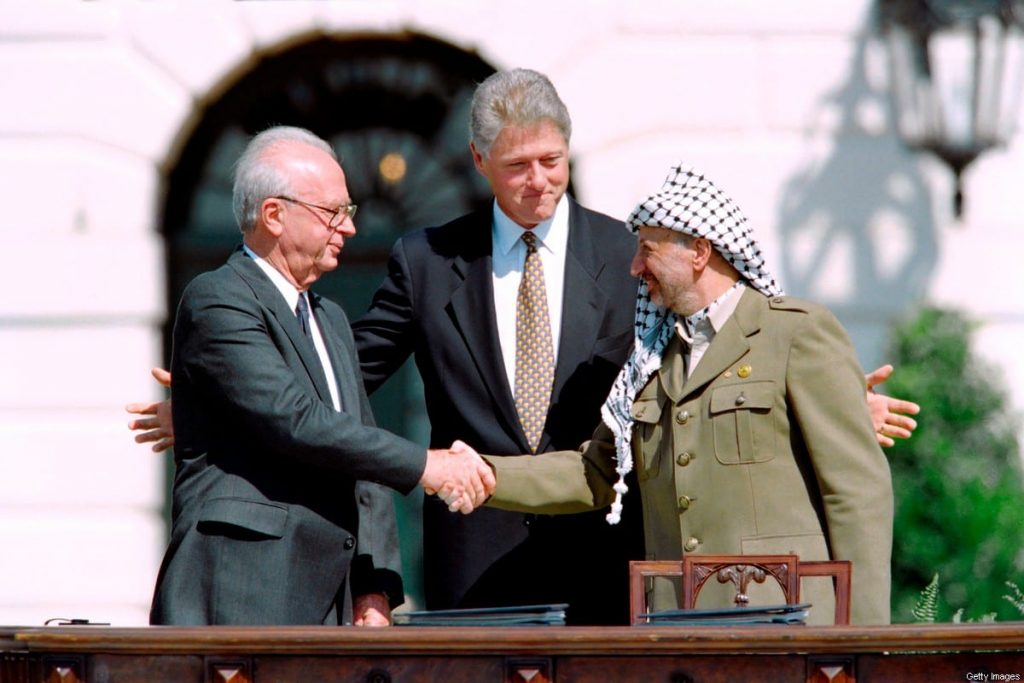
Once upon a time I was staying in a New York Hotel. Waking up and switching on the TV, I learnt that Israel and the group which, from then on, was to be recognized as the Palestinian Authority (PA) had reached an agreement designed to open the way towards what later became known as a “two-state solution” and full peace. Never in my life have I felt happier! The date? 13 September 1993.
Today, Thursday, is 14 September. So follow some Q&A about the Oslo Agreements, so called after the Norwegian capital where much of the negotiation process had taken place.
Who were the signatories of the Oslo Agreements?
On the Israeli side it was then Prime Minister Yitzhak Rabin; on the Palestinian one, PA chief Yasser Arafat.
What were the main points of the Oslo Agreements?
Given that the Agreements comprise over 300 pages containing 5 “chapters” with 31 “articles”, plus 7 “annexes” and 9 attached “maps,” this is a hard question to answer. Still, the following essentials are indispensable for any kind of understanding. First, the PA promised to give up terrorism, agreed to recognize Israel’s right to exist, and undertook to enter negotiations towards a “final” peace. 2. Israel recognized the PA as representing the Palestinian People and agreed to work with it in order to reach a peace agreement. 3. The West Bank was to be divided into three discontinuous zones. One under full Israeli control (both security and civilian), one under the joint control of Israel and the PA, and one under full Palestinian control; Israel’s security forces were to “redeploy” accordingly. 4. The various Palestinian paramilitary organizations then existing in the West Bank and the Gaza Strip were to be united under the authority of the PA and used to look after the security of those areas; no additional such organizations were to be recognized or newly established. 5. Israel and the PA were to work together in suppressing terrorism. 6. The agreements were deemed to be provisional, allowing five years for reaching a permanent settlement based on Security Council Resolutions 242 and 338. 7. Both signatories would treat each other with due regard to internationally-accepted norms and principles of human rights and the rule of law, including an end to hostile propaganda and education.
Why did the Agreements fail?
One cardinal reason was the assassination by a Jewish terrorist of Prime Minister Rabin, the only Israeli with the authority to—perhaps—pull it off. Followed by his replacement, a few month later, by a series of more right-wing leaders—of whom the most important by far was Benjamin Netanyahu—who refused to do so.
That apart, almost from the beginning, both sides failed to act in the spirit, sometimes even the letter, of the Agreements. Though there were ups and downs the PA, either because it couldn’t or because it wouldn’t, never put an end to terrorism either in the West Bank of in the Gaza Strip. Nor did it stop its propaganda against Israel. Israel on its part only redeployed its forces in a symbolic way, leaving both the West Bank and the Gaza Strip (the latter, until 2006 when it finally withdrew its forces) under full military control.
More important still, three cardinal problems. They are, 1. The question of the settlements, now allegedly containing a population of 500,000, which Israel has built in the Territories and which it insists on eventually turning into part of its own sovereign territory. 2. The right of the Palestinians to return to the homes they were forced to leave back in 1948 and 1967, including not only those in the West Bank and the Gaza Strip but in “old” Israel: too; and 3. The question of Jerusalem, which Israel insists must remain under its sole control and the PA demands be divided between the two sides.
And the future?
Bad for everyone. The Holy Land remains a not-so-dormant volcano ready to explode at any moment. To this, one might add the quite real possibility of Israel going up in flames as Left and Right battle each other over profound political, social and constitutional issues that are even now tearing it apart.
Meanwhile, for demographic and other reasons, both Israeli’s system of government and its public opinion have been moving steadily to the right. The younger the voter the more true this is, causing the future to look dark indeed. The worst scenario would be an attempt by some future Israeli right-wing government to use terrorism as an excuse to do away with what is left of the Agreement and expel the Palestinians of the West Bank in particular into what is now the Kingdom of Jordan. Such a move, akin to the expulsion of hundreds of thousands of Palestinians in 1948 and 1967, would very likely draw additional countries such as Iran, Lebanon and Syria into the fray. In addition, it would almost certainly nullify much of the progress that has been made towards a wider Israeli-Arab- and Israeli-Islamic peace. Feeling beleaguered on all sides, and possibly beset by civil war as well, Israel’s government, or what remains of it, might get to the point where it threatens using some of the 100-400 nuclear warheads which, according to various foreign sources, it has.
Or worse.
